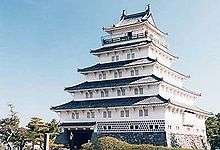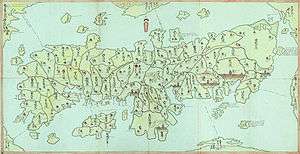Shimabara Domain

The Shimabara Domain (島原藩 Shimabara-han) was a Japanese domain of the Edo period. It is associated with Hizen Province in modern-day Saga Prefecture.[1]
In the han system, Shimabara was a political and economic abstraction based on periodic cadastral surveys and projected agricultural yields.[2] In other words, the domain was defined in terms of kokudaka, not land area.[3] This was different than the feudalism of the West.
History
The Arima clan, who were Kirishitan daimyō, ruled over Shimabara Domain in the late Muromachi period from Hinoe Castle and Hara Castle. After the start of the national isolation policy, the Tokugawa Bakufu banned Christianity from 1614 and replaced Arima Naozumi with Matsukura Shigemasa. Matsukura, who strictly enforced the prohibition against Christianity with mass executions, also severely raised taxes to pay for the construction of his new Shimabara Castle from 1618-1624. This oppression of the peasants was a major factor leading to the Shimabara Rebellion.[4]
After the rebellion was suppressed, the domain was given to the Kōriki clan. It then passed to the Fukōzu-Matsudaira family, who ruled it from 1668 until 1871 (with a brief hiatus from 1747-1774).
In the Bakumatsu period, Matsudaira Tadachika became an influential official in the Tokugawa administration. However, the final daimyo of Shimabara, Matsudaira Tadakazu pledged Shimabara domain in support of Emperor Meiji in the Boshin War, proved his loyalty by committing his troops to the northern campaign against the Ōuetsu Reppan Dōmei, fighting at Akita and Morioka.
List of daimyo
The hereditary daimyo were head of the clan and head of the domain.
- Arima clan, 1600-1614 (tozama; 28,000 koku)[5]
Name Tenure Courtesy title Court Rank Revenue 1 Arima Harunobu (有馬晴信) 1600-1612 Shūri-daiyū (修理大夫) Lower 5th (従五位下) 40,000 koku 2 Arima Naozumi[5] (有馬直純) 1612-1614 Saiemonfu (左衛門佐) Lower 5th (従五位下) 40,000 koku
- Matsukura clan, 1616-1638 (tozama; 40,000 koku)[6]
Name Tenure Courtesy title Court Rank Revenue 1 Matsukura Shigemasa (松倉重政) 1616-1630 Bungo-no-kami Lower 5th (従五位下) 40,000 koku 2 Matsukura Katsuie (松倉勝家) 1630-1638 Nagato-no-kami Lower 5th (従五位下) 40,000 koku
- Kōriki clan, 1638-1668 (fudai; 40,000 koku)[7]
Name Tenure Courtesy title Court Rank Revenue 1 Kōriki Tadafusa (戸田忠盈) 1638-1655 Sakontaiyu (左近大夫) Lower 5th (従五位下) 40,000 koku 2 Kōriki Takanaga (戸田忠寛) 1655-1668 Sakontaiyu (左近大夫) Lower 5th (従五位下) 40,000 koku
- Matsudaira (Fukōzu) clan, 1669-1749 (fudai; 70,000 koku)[8]
Name Tenure Courtesy title Court Rank Revenue 1 Matsudaira Tadafusa (松平忠房) 1669-1698 Tonomori-no-tsukasa (主殿頭) Lower 4th (従四位下) 65,000 koku 2 Matsudaira Tadakatsu (松平忠雄) 1698-1735 Tonomori-no-tsukasa (主殿頭) Lower 4th (従四位下) 65,000 koku 3 Matsudaira Tadami (松平忠俔) 1735-1738 Tonomori-no-tsukasa (主殿頭) Lower 5th (従五位下) 65,000 koku 4 Matsudaira Tadatoki (松平忠刻) 1738-1749 Tonomori-no-tsukasa (主殿頭) Lower 4th (従四位下) 65,000 koku 5 Matsudaira Tadamasa (松平忠祗) 1749 Tonomori-no-tsukasa (主殿頭) Lower 4th (従四位下) 65,000 koku
- Toda clan, 1749-1774 (fudai; 77,000 koku)[9]
Name Tenure Courtesy title Court Rank Revenue 1 Toda Tadamitsu (戸田忠盈) 1749-1754 Hyuga-no-kami Lower 5th (従五位下) 77,000 koku 2 Toda Tadatō (戸田忠寛) 1754-1774 Iki-no-kami Lower 5th (従五位下) 77,000 koku
- Matsudaira (Fukōzu) clan, 1774-1871 (fudai; 70,000 koku)[8]
Name Tenure Courtesy title Court Rank Revenue 1 Matsudaira Tadahiro (松平忠恕) 1774-1792 Yamato-no-kami Lower 5th (従五位下) 65,000 koku 2 Matsudaira Tadayori (松平忠馮) 1792-1819 Tonomori-no-tsukasa (主殿頭) Lower 5th (従五位下) 65,000 koku 3 Matsudaira Tadayoshi (松平忠侯) 1819-1840 Tonomori-no-tsukasa (主殿頭) Lower 5th (従五位下) 65,000 koku 4 Matsudaira Tadanari (松平忠誠) 1840-1847 Tonomori-no-tsukasa (主殿頭) Lower 5th (従五位下) 65,000 koku 5 Matsudaira Tadakiyo (松平忠精) 1847-1859 Tonomori-no-tsukasa (主殿頭) Lower 5th (従五位下) 65,000 koku 5 Matsudaira Tadaatsu (松平忠淳) 1859-1860 Tonomori-no-tsukasa (主殿頭) Lower 5th (従五位下) 65,000 koku 5 Matsudaira Tadachika (松平忠愛) 1860-1862 Tonomori-no-tsukasa (主殿頭) Lower 5th (従五位下) 65,000 koku 5 Matsudaira Tadakazu (松平忠和) 1862-1871 Tonomori-no-tsukasa (主殿頭) Lower 5th (従五位下) 65,000 koku
See also
References

- ↑ "Hizen Province" at JapaneseCastleExplorer.com; retrieved 2013-5-28.
- ↑ Mass, Jeffrey P. and William B. Hauser. (1987). The Bakufu in Japanese History, p. 150.
- ↑ Elison, George and Bardwell L. Smith (1987). Warlords, Artists, & Commoners: Japan in the Sixteenth Century, p. 18.
- ↑ Murray, David. (1905). Japan, pp. 258-259.
- 1 2 Papinot, Jacques Edmond Joseph. (1906). Dictionnaire d’histoire et de géographie du Japon; Papinot, (2003). "Arima" at Nobiliare du Japon, p. 3; retrieved 2013-6-7.
- ↑ Papinot, (2003). "Matsukura" at Nobiliare du Japon, p. 33; retrieved 2013-6-7.
- ↑ Papinot, (2003). "Kōriki" at Nobiliare du Japon, p. 24; retrieved 2013-6-7.
- 1 2 Papinot, (2003). "Matsudaira (Fukzmizo)" at Nobiliare du Japon, p. 31; retrieved 2013-6-7.
- ↑ Papinot, (2003). "Toda" at Nobiliare du Japon, pp. 60-61; retrieved 2013-6-7.
External links
- "Shimabara" at Edo 300 (Japanese)